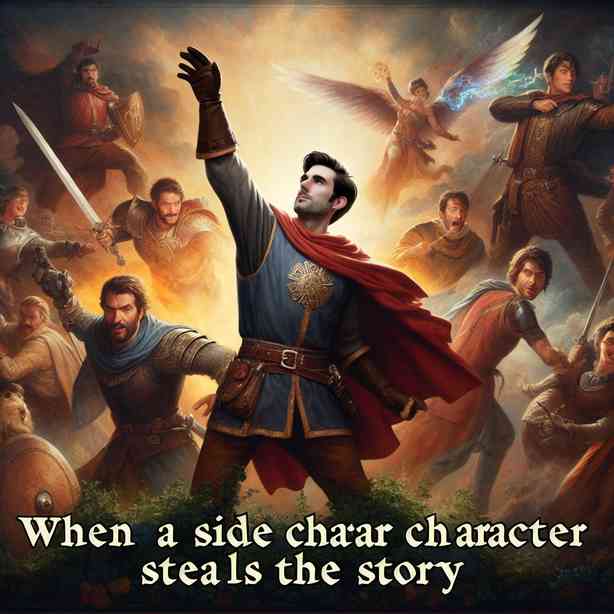
In the realm of storytelling, the primary focus is often placed on the protagonist, the hero who embarks on a journey filled with challenges, growth, and transformation. However, there are instances where side characters, often referred to as secondary or supporting characters, take the spotlight and, in doing so, enrich the narrative in unexpected yet profound ways. This phenomenon of side characters stealing the story has become increasingly prominent, capturing the hearts of audiences and reshaping the dynamics of storytelling.
To understand how and why side characters can eclipse the main protagonist, it’s essential to delve into the mechanics of character development and dynamics within a narrative. Side characters are typically crafted to complement the main character’s journey. They provide essential context, serve as foils, or contribute to the thematic arc of the story. However, certain side characters possess traits, backstories, or motivations that resonate so deeply with audiences that they may inadvertently overshadow the protagonist.
One of the key aspects that allow side characters to shine is their complexity. When writers imbue side characters with rich backgrounds and multi-dimensional personalities, they become more relatable and engaging. For example, in the world of literature, characters such as Severus Snape from J.K. Rowling’s Harry Potter series or Samwise Gamgee from J.R.R. Tolkien’s The Lord of the Rings depict how a well-developed side character can elicit emotional investment from the audience. Snape’s layered history and moral ambiguity invite readers to rethink their perceptions of good and evil, while Sam’s unwavering loyalty and bravery demonstrate selflessness and friendship, themes that resonate universally.
Furthermore, the role of side characters as catalysts for the protagonist’s development cannot be overlooked. They often challenge the main character’s beliefs, compel them to confront their shortcomings, or provide support during moments of crisis. Such interactions can lead to pivotal character growth. For instance, in Disney’s Frozen, the comedic yet insightful character Olaf provides not only comic relief but also profound life lessons about love and selflessness that resonate with the audience. His ability to articulate complex emotions in simple terms allows viewers to grasp the story’s central theme while making him an unforgettable element of the narrative.
Additionally, the emotional connection that audience members develop with side characters can play a crucial role in how the story is perceived. In visual storytelling mediums, such as film and television, side characters often bring a unique charm that can create moments of levity or tension that are memorable and impactful. Consider the character of Dobby in the Harry Potter series. His journey from a reluctant house-elf to a symbol of freedom showcases resilience and sacrifice. Audiences often feel a mix of compassion, humor, and heartbreak through his experiences, establishing him as a beloved character who leaves a lasting imprint long after the story concludes.
Side characters also serve vital thematic purposes. They can embody societal norms, provide contrasting perspectives, or even highlight the flaws of the protagonist. When viewed through this lens, the secondary characters often embody issues that are relevant to the audience’s reality. For example, in the acclaimed television series Friends, characters like Monica and Chandler navigate the complexities of relationships and personal growth, while Ross often acts as a representation of unresolved conflict and learning through trial and error. Such representations make the narrative richer and more relatable, allowing viewers to reflect on their own lives.
Moreover, storytelling has evolved significantly in recent years, particularly with the rise of ensemble casts in various genres. This shift allows multiple characters to share the narrative spotlight, illustrating that diverse perspectives foster deeper understanding and engagement. In shows like Game of Thrones, although characters like Daenerys Targaryen and Jon Snow may be central, characters such as Tyrion Lannister and Arya Stark captivate audiences with their unique arcs, wit, and resilience. This illustrates how multiple voices contribute to storytelling, enhancing the overall experience while allowing different characters to resonate with various audience segments.
However, the balance between protagonists and side characters is delicate and requires careful navigation from writers. While side characters can offer enrichment to the story, their role should ideally support, rather than overshadow, the main character’s journey. When a side character’s story becomes more compelling than the protagonist’s, it can lead to narrative discord, leaving audiences feeling unsatisfied or confused. Therefore, it’s crucial for writers to ensure that each character’s arc serves a purpose within the greater narrative framework.
In conclusion, the phenomenon of side characters stealing the story is not merely a result of a poorly developed protagonist. Rather, it reflects a deeper trend in storytelling that celebrates complexity, relatability, and thematic richness. As audiences gravitate toward narratives that offer a spectrum of experiences, side characters who are well-crafted can emerge as essential components of storytelling, enhancing the journey and enriching the emotional landscape of the narrative. By embracing the intricacies of character development, both writers and audiences can explore the profound layers that characters bring to a story, leading to a deeper appreciation of the art of storytelling itself. This evolution in narrative structure not only enlivens character dynamics but also encourages a thoughtful exploration of what it means to be human through the lens of every character, main or side.


